KINDER SCOUT
Some visitors are drawn to the gentle beauty of the vale of Edale, others to the grandeur of the valleys or the majesty of the edges. Some come to enjoy the wide solitude of the vast plateau and the dark northern reaches. Whilst others are drawn to the western slopes, witnesses to the spectacular birth of the river Kinder.
Standing high above the surrounding hills the huge span of the dark and often mist shrouded edges of the Kinder plateau dominate the local landscape. Higher than the nearby vastness of Bleaklow and the sticky realms of Black Hill to the North. Kinder can, on a clear day command views to places as far away as Snowdon.
Kinder Scout, the name will suggest something different to everybody. Those who have walked the edges or the groughs in wet weather or fog will have a dark view of the place. Reporting perhaps that it was a featureless desert of black clinging peat broken only by steep sided gulleys cutting down to the naked stone below.
However, anyone lucky enough to travel Kinder in fair weather will have gained a very different impression. The steep edges rise quickly out of the picturesque valleys below helping the walker to rapidly gain height. Each of the valleys or Cloughs, as they are known, places different demands on the ascent, but each has its own rewards. For whether you choose to follow the stream up the Clough to the point where it tumbles from the plateau or would rather climb more directly up one of the many smaller side Cloughs, the views open rapidly. To the North, South and East the eye is drawn deep into the National Park. The folds of billowing hilltops begin to range into view for as many miles distant as the atmosphere will allow. Whilst an ascent of the western edges will reveal beyond New Mills, the fringes of the Cheshire Plain across which the estuary of the Mersey might be glimpsed before the distant Welsh hills and even Snowdon come into view. Whether you choose to look near or far from the heights of Kinder Scout there is something to draw the eye.
In winter, the harsher aspects of the edges and plateau are often whitened by frost, which, can be laid down to depth, by wave after wave of freezing fog. The strands of thin grass and stalks of the heather and bilberry are built up like bone by the freezing clouds. Watercourses become frozen, shining with a dull light as they progress down into the bottom of the Cloughs. Icicles can be found hanging to dramatic lengths from beneath rocks and crags, but it is by the Downfall that the most spectacular scenes are to be found. Ice often hangs in huge sheets not only from the watercourse, but also from the surrounding rocks and tufts of grass. The whole area giving the viewer the impression that it is cut from glass.
A fall of snow will often lie on Kinder and its edges long before or after it has melted from the land around, giving the plateau the true look of a mountain. The hard grit stone edges and the rock-strewn sides softened by the deep drifts.
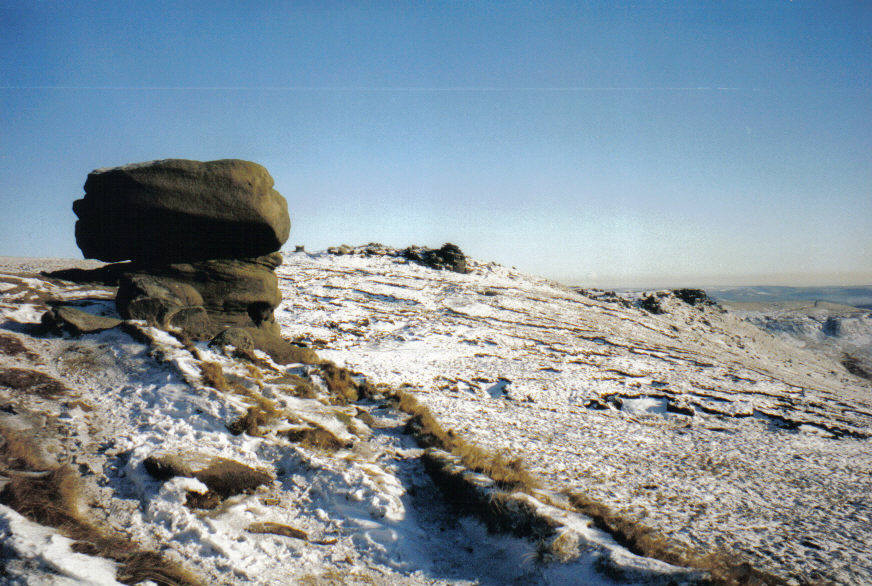
In any conditions an ascent of the edges will bring the traveller to the broad eroded trail, which snakes its way right around the summit. This much used and in part ancient track follows closely along the edges never venturing farther than necessary from the Tors. It is likely that parts of the track are many hundreds of years old, used perhaps by our ancestors to traverse the once thickly wooded landscape. Certainly there is much evidence of the “jaggers” with their packhorses crossing the area. A Clough at the eastern margin still bears their name.
The peat edges of the plateau rise to form one side of the track. Lightly covered with pale grass or ancient heathers the mounds of peat are cut by deep gulleys carved out by the passage of water making its way to the edges. As one looks into this strangely featured interior in the summer it is often possible to see plumes of steam rising from the drying peat. The land rolls and rises, so that at times the horizon is only a few hundred yards away.
The interior of the plateau has a charm of its own. Though it hasn’t always been appreciated. In his1894 guide to the Peak M. J. B. Baddeley described an ascent of Kinder Scout “the wide table land that constitutes the top of Kinder Scout is according to the Ordnance Map, the “ Peak ” par excellence, though oddly it does not contain a single feature to justify the name. It extends for about four miles from west to east, and at its widest part, one and a half miles north to south… the walking over this plateau is the worst imaginable. The vegetation consists of rank long grass and stunted heather, and the floor is of deeply rutted peat.”
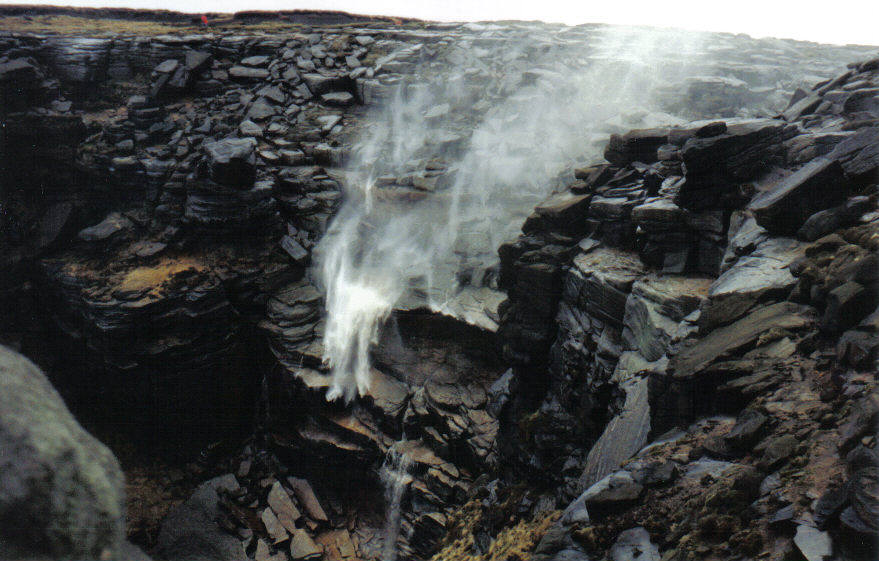
It would seem that the tastes of the 19th century are not reflected today. Though I am sure some people might agree with Baddeley’s sentiment. I believe that most appreciate that the summit of Kinder has much to offer in the way of quiet solitude. It does not share the harsh and dramatic scenery of the edges and yet there is a beauty in the regularity of its rolling groughs and islands of heather and bilberry.
There are paths, which cut through the plateau. The Pennine Way follows one from the top of Grindsbrook Clough through the interior to the Kinder Gates. Irregular timber stumps mark its course, but even so it can prove hard to follow in a mist. Dipping as it does up and down through the peat groughs. In places on the plateau these groughs are six or more feet deep and steep sided. Though it is easy to drop down into the stony watercourse in the base, the walker may then be forced to travel for many yards to the left or right before being able to climb out of the other side. This can quickly disorientate the inexperienced.
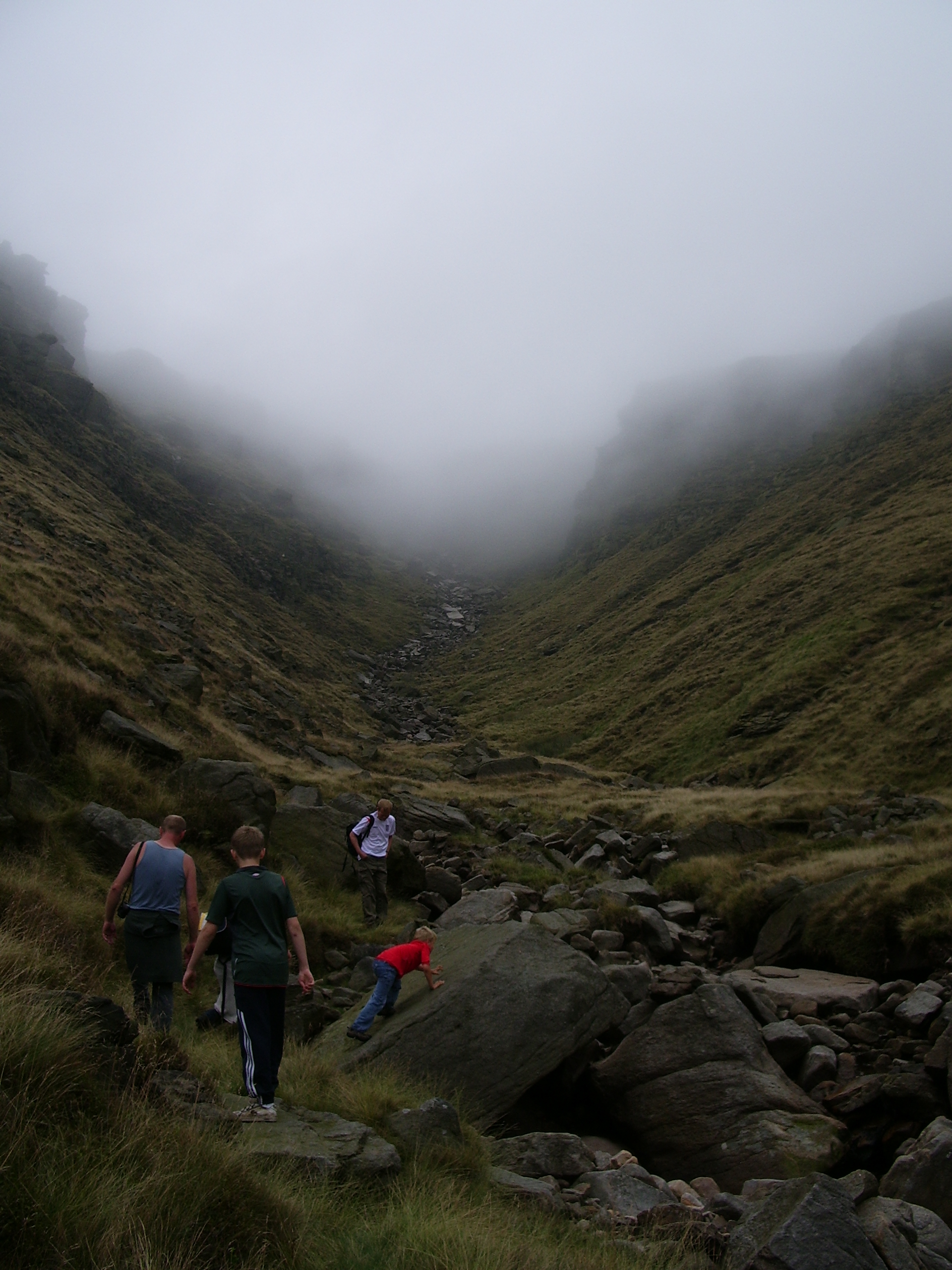
The effects of erosion over many millennia have left many large, heavily weathered rocks standing proud of their surroundings. These rocks now provide some of the best known landmarks on Kinder. Many of them are amongst the few named items on the plateau, making them widely used as aids to navigation. As a consequence of this use rocks such as Pym Chair, Druid stone, Mad Woman Stones and The Boxing Glove Stones have become widely known and much visited.
These were among some of the first stones that I photographed on Kinder. The shapes and names of the various stones are fascinating they seem to fall into three groups. Some of them bear names that refer to their history. Pym Chair allegedly owes its name to the non-conformist minister John Pym who reputedly held services nearby in the seventeenth century. The Druids Stone bears a striking resemblance to an ancient alter of sorts, but it’s unlikely that it was ever used for the purpose of sacrifice. That distinction is more likely to belong to the small hillock, the remains of a burial cairn on Nether Moor some way below. Madwoman’s Stones on Upper Moor are a collection of flat stones. The origin of the name may be unknown, but it is suggestive.
Other rocks or groups of stones have names that more obviously refer to their shape. The Boxing Glove Stones, not far from Ashop Head on the northern edges, clearly resemble a raised boxing glove. Punch’s Nose, also on the northern escarpment is another rock whose name needs little explanation.
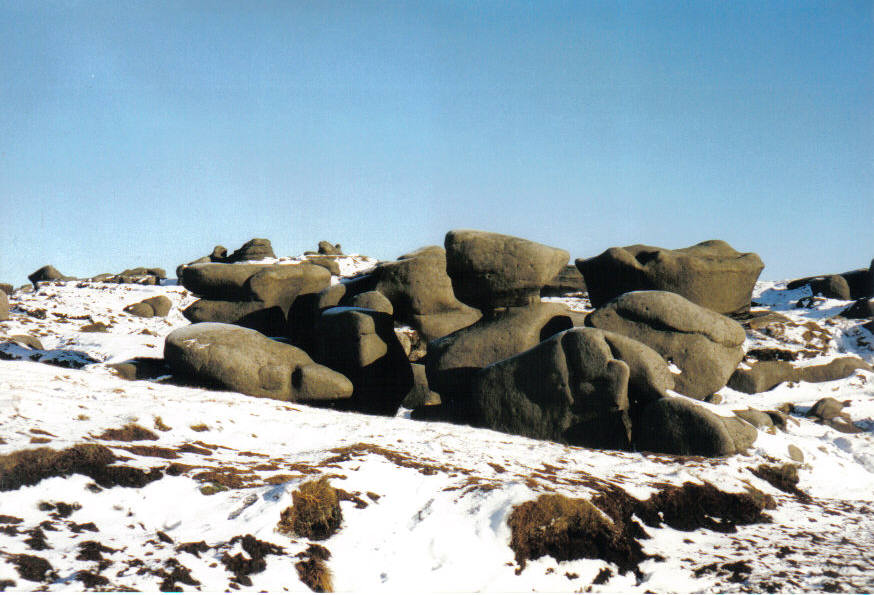
The third group of rocks has more abstract names. The Pagoda is a collection of huge flat stones laid on top of one another at the western end of the Woolpacks. Crowden Tower is a massive Tor at the head of Crowden Clough. Ringing Roger is a formation of rock on the edge above the mouth of Grindsbrook Clough. This is one of the more peculiar names, though it does seems likely that the Roger element is a corruption of the French word “ Rocher ” or rock. The French influence could easily have developed from the Norman stronghold at Castleton. The Moat Stone has earned its name by virtue of the fact that it is surrounded by a shallow pool which interestingly, despite prolonged spells of dry weather never seems to dry out.
I had photographed many of these well known landmarks over the course of several years. Gradually I began to notice that there were many other stones, which though not so well known, had great merit in their resemblance to animals or abstract features. In seeking out these shapes an open mind is the greatest asset. Often I have passed a stone or rock formation on several occasions before realizing its hidden charm. Some of these formations have been sculptured by the elements into shapes that seem scarcely possible. Carved not with the regularity that one might imagine, but rather almost randomly as the weather has exploited any weakness it found in the stone. Frequently some of the best features of a stone would only become fully apparent when highlighted by snow or frost. Other formations could remain completely unnoticed until viewed from the perfect angle. Then the true shape of the stone would reveal itself.
On the southern edges of Kinder Scout, between Crowden Tower and the Pagoda, lie the Woolpacks. This area, much of which lies on a promontory below the encircling track, has one of the highest densities of weather eroded stones on Kinder. The Woolpacks are also sometimes referred to as Whipsnade, perhaps a modern reference to the zoo, or by the equally modern title the Mushroom Garden, which aptly describes the appearance of the many Grit stone rocks. Within the large region covered by these savagely eroded boulders strange forms abound. There is hardly a stone that is not sculptured to some dramatic form. Many of these large stones stand freely on narrow bases rising to a height of up to eight feet. That they balance is scarcely to be believed and yet they have done so for millions of years, whilst the elements have relentlessly worn down their stature. I have taken the liberty of adding names to these “new found” stones myself. In doing so I have tried to avoid names of the modern era. It is one of the remarkable things about Kinder that no ancient names or legends seem to have attached themselves to these stones or any of the other remarkable stones of the edges. Indeed, it would seem that many of the names on and around the summit of Kinder are of no great antiquity. In other areas, such as the Roaches there are many names and ancient legends attached to individual rocks. I find it hard to believe that the same did not apply to the sculptured stones of Kinder in the past. Perhaps it did.
I wonder what these strange stones looked like thousands of years ago when the plateau was a forest. How did the ancient peoples of the area regard them? Evidence of our ancestors is easy to see from Kinders southern flank across the valley are the remains of the Iron Age Hill Fort and settlement at Mam Tor. Further east along the Great Ridge at Back Tor evidence of a far older habitation has been found. On Rushup Edge there is an ancient burial mound, named the Lords Seat. Another raised on the large spur at the southwestern extremity of the plateau has given its name to Kinder Low End from where it commands the heights. Interestingly, there is no other recognised Cairn on the plateau or the high edges, which could be significant as these ancient people often sought high ground for their burials.
Some of the stones I have photographed command a haunting resemblance to animals. Imagine for a moment that you are following a deer through the thickly stunted trees that cover the whole uplands of Kinder when in a clearing you come face to face with Dog Rock; or perhaps you are confronted with the line of standing stones which guard the Woolpacks an area full of strange dark shapes glimpsed between the undergrowth. Remember these are a people who raise stones for their own purposes. The people who built the Henge’s at Dove Holes and Arbor Low and who mark the landscape with the burial mounds of their dead. Perhaps the effect of such an encounter would have been profound.
In later times the need to fuel the fires of the Iron Age and to open the land for grazing animals would have gradually overcome the superstition of those earlier people. But perhaps the sense of awe with which they viewed their landscape is inherent. For I suspect that few people would not be awed today coming to the same place for the first time.
Stephen Lewis 03
LEGEND OF THE MERMAIDS POOL – KINDER SCOUT
The Mermaids pool lies on a small plateau above the Peter Nook Wood, this quite large and deep pool has an ancient legend attached to it. The modern legend says that if you seek everlasting life, then you should journey to the pool in the early hours of the morning of every Easter Sunday and await the mermaid. If she rises then you must bargain from her a wish of immortality. A variation says that bathing in the pool on Easter Sunday will bestow long life.
The legend has another and far older variation, which perhaps wasn’t to the taste of those romanticising our past. Fortunately, it was recorded in a poem by notable historian Henry Kirke.
There is a certain mountain in the Peak, at whose foot lies a pool, from which a maiden is said to rise on Midsummer’s Eve, and by her singing lure men to destruction. The water of this pool is salt and bitter, for it is said to be connected with the far distant Atlantic.
There is a land within a northern clime
Where many a mountain reaches to the clouds, 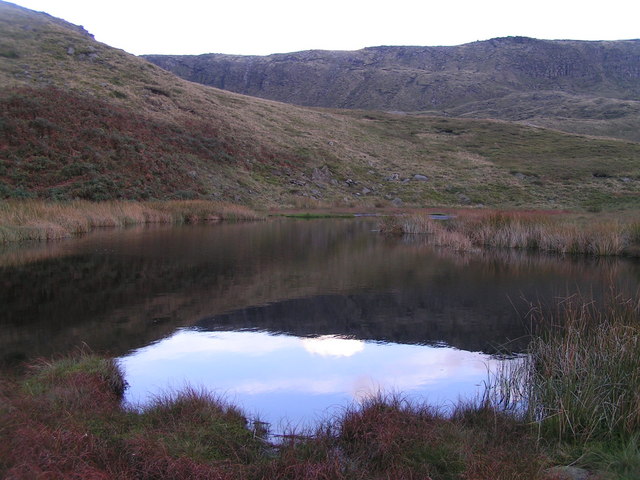
That rest their billowy fleeces on its head,
And roll adown its rugged, storm-rent sides.
At foot of such a mountain in this land
There lies a pool, dark and mysterious,
Shadowed by blackened rocks, and sedges drear,
In which no reedy warbler builds its nest;
No heather nods its bells unmusical
Around its banks no sombre-coated bee
Hums over it a busy melody;
No speckled trout or dark-backed umber there
Wake the still waters with their circling leaps;
No chattering grouse drops in the doubtful wave
Feathers that float like tiny argosies;
Nor furry-footed coney stops to drink
Its waters salt as those their watch that keep
Over the doomed towns of Palestine.
With solemn awe the lonely shepherd treads
Passed the weird margin of the mountain tarn,
Fearing the spite that dwells within its depths,
And rot, and ague, and a thousand ills
He thinks such fearsome folk are wont to give
To those that trespass on their sovereignty.
But one there was a sprightly lad and tall,
And gifted with a face in which for mastery
Action and thought seemed always combating,
Who always felt attracted to the pool,
And sat for many hours plumbing its depth
With anxious eyes; but nought saw he therein
Save the reflection of his comely face.
Warning he had full oft from wiser men
To meddle not in such a dangerous quest,
Nor seek for death where death was surely found:
For tis believed that on a certain eve
When summer fruits are ripe, and in the sky
The stars can scarcely light their shining lamps,
And the soft air is strangely musical
With the faint hum of fairy merriment,
A maiden, strangely fair, but strangely formed,
Rises from out the pool, and by her songs
And heavenly beauty lures to shameful death
The luckless wight who hears her melodies.
But youth is curious, and the shepherd lad
Longed with intense desire to see the maid.
He dreamt of her by night, her white arms seemed
To lock him in a clinging, fond embrace;
She haunted him by day as moodily
He watched beside the pool, and seemed to see
In each reflected cloud her drapery.
At last the night arrived, the sun just dipped
His rosy fingers in the pathless sea,
Leaving the world not dark, but hardly light;
The waning stars scarce marked the azure sky,
And zephyrs gentle cooled the heated earth:
T’was just the hour when night and morning meet,
When, watching still, the boy sat eagerly,
On a huge stone that darkened all the pool;
When suddenly the wave gleamed fitfully
With sudden light, as in the tropic seas
The lambent waves shine with phosphoric glare,
And brighter grew the water, and the air
Was filled with music ravishingly sweet.
With open mouth and eager starting eyes
The youth stood gazing at these mysteries,
And saw from out the troubled waves arise
A maiden, clothed alone in loveliness;
Her golden hair fell o'er her shoulders white,
And curled in amorous ringlet round her breasts;
Her eyes were melting into love, her lips
Had made the very roses envious;
Withal a voice so full, and yet so clear,
So tender, made for loving dialogues.
And, then, she sang-sang of undying love
That waited them within her coral groves
Beneath the deep blue sea, and all the bliss
That mortals made immortal could enjoy,
Who lived with her in sweet community.
She sang, and stretching out her rounded arms,
She bade him leap and take her for his own-
With one wild cry he leapt, and with a splash
That roused the timid moorhen from her nest,
Sank 'neath the darkling wave for evermore.
KINDER CAVERN
Myth, or lost, many have searched in vain since the following article appeared in 1831.
''Kinder Low Subterraneous Cavern.
Among the many wonderful caverns in Derbyshire, none seem, for extent and internal beauty, more to merit the attention of the curious observer of the hidden works of nature in her wild recesses, than the one, which was explored on the 10th of July, 1830. It cannot consistently be said that this cavern is newly discovered, as the mouth has been seen a considerable number of years by the shepherds visiting the mountains, but none before ever dared to venture to search into it. It is a well known fact in the recollection of several persons at Hayfield, that about twelve years ago, a party being out shooting on the hills, called Kinder Low, a covey of birds sprung up, when one of the party, not being ready to fire, threw his hat at them, which being carried by the wind, went down the mouth of the cavern, and one of them threw a stone down, which striking the hat (as is supposed) lessened the sound, so that the persons at the top concluded there was no bottom. However, on the day above-mentioned, a number of persons determined, if possible, to explore it: and having been previously informed of the exact situation, and providing themselves with every requisite, they arrived at the mouth, which, by its terrific appearance, almost daunted the courage of the most resolute. The entrance to the first landing is by a perpendicular descent of about five yards, when they again made a similar fall of four yards to the second landing; the day disappearing, they lighted their flambeaux and candles, and proceeded down a steep descent in a westwardly direction. The sides and roof in this part are composed of huge masses of rock, so regularly and compactly united that it might be the work of an architect; and after going through innumerable chambers, which for extent and loftiness of the roof, are not inferior to the most celebrated in Peak's Hole, they discovered an opening in the floor, though which they with difficulty descended, and found themselves in a part of the cavern which runs in a direction exactly parallel with the part above. Here the largest chamber they had gone though, seemed only as the portico to this amazing cavern: the eye could scarcely reach the lofty ceiling, the sides and floor of which were regularly formed of immense masses of solid rock.
As they proceeded further in this subterraneous abode they passed through many rooms similar to the former; in this part of the cavern there is a kind of soft stone, something between rottenstone and fuller's earth. But the lights being nearly consumed, they, without further delay, began to retrace their steps, for it would be impossible for any persons to find his way back without light, owing to the innumerable openings branching out in every direction, it was with difficulty the party could find their way out, though each had a light in his hand. Having attained the surface, they found they had been under ground one hour and forty-five minutes, the whole of which time had been taken up in going though the cavern. It is more than probable that there is a great part yet undiscovered for by every appearance, they had not gone though the half, as there were so many crevices. Kinder Low cavern is situate about a mile north-west of the Downfall, on the Scout. It is the opinion of several persons well acquainted with the strata of the rock, that one fourth of the hills in this neighbourhood are subterraneous, and with a little exertion, mines more extensive than any yet discovered in Derbyshire, would be found to exist. "
The history and gazetteer of the county of Derby
By Stephen Glover
Published, 1831
There is however an actual cavern on Kinder Low, known as The Belfry.
“ A short crawl leads to a chamber with two alternative slots down a 12 foot drop to a chamber 6 to 7 feet wide by about 20 to 25 feet long.”
The Belfry is at approx SK 06817 86555. The entrance can be seen from the Coldwell Clough to Edale Cross pathway high among the rocks on Kinder Low. The entrance faces directly at South Head.
There is another legend that refers to the cavern mentioned in the article of 1831. Suggesting that the Game Keepers acting on instructions to deter sightseers and potential cavers covered the entrance using sleepers and peat. This cave is supposed to lie toward Three Knolls.
One final clue is a pencil image of the cavern drawn in 1864 it appears in 'KINDER SCOUT with footpaths and bridle roads about Hayfield.’ By Luke Garside, published in 1880.

.jpg)
 |







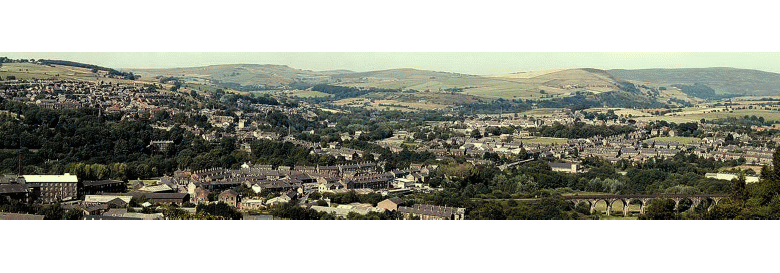







.jpg)